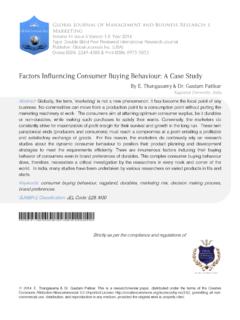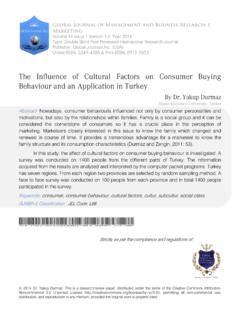Transcription of An investigation of consumer behaviour in mobile phone ...
1 an investigation of consumer behaviour in mobile phone markets in Finland Submission to 32nd EMAC conference, Track: New Technologies and E-Marketing Jukka Pakola, , Assistant in Economics, Marjukka Pietil , , Researcher in Economics, Rauli Svento, , Professor in Economics, Heikki Karjaluoto1, Dr., Professor in Electronic Commerce, All at the Faculty of Economics and Industrial Management, University of Oulu 1 Faculty of Economics and Industrial Management, University of Oulu, 4600, FIN-90014 University of Oulu, e-mail: Tel: +358 8 553 2946, Fax: +358 8 553 2906 2 Abstract In recent years, the adoption of mobile phones has been exceptionally rapid in many parts of the world, and especially in Finland where cellular phones are nowadays almost as common as wrist watches. While mobile phone usage is rather an unexamined genre in academic literature, this exploratory study attempts to investigate consumer purchasing motives in cellular phone markets.
2 This paper surveyed 397 Finnish consumers and looked at their motives to purchase new mobile phones on one hand and factors affecting operator choice on the other. The results indicate that while price and properties were the most influential factors affecting the purchase of a new mobile phone , price, audibility and friends operator were regarded as the most important in the choice of the mobile phone operator. This paper concludes with a discussion of contributions and proposes ideas for future studies in this underresearched area. Key words: consumer behaviour , mobile phone usage, Finland Introduction This paper purposes to study the motives that affect consumer behaviour as well as give insights into the use of mobile phone services including the perceived value-added services, and to collect general information about the users.
3 Although it is evident that the large players in the telecommunications business constantly conduct market research, the problem is that the results obtained are usually kept inside company walls and therefore consumer behaviour in mobile phone industry is an unexamined genre in academic literature. On this basis this investigation first describes the trends in the information and telecommunications (ICT) sector in order to illuminate the issues underlying consumer behaviour . This will be followed by review of recent studies concerning factors that seem to affect the choice of a mobile phone , operator as well as intention to adopt new mobile phone features and services such as multimedia messaging service (MMS) and sending e-mails. Finally, the paper reports the survey findings and ponders managerial and theoretical implications.
4 Literature review The time we are living is maybe one of the most fascinating times to study mobile phone purchasing motives and perceptions of new mobile phone services. Although quite many instances have challenged the need for new mobile services ( Bradner, 2002; Wagstaff, 3 2002), the current trend in the mobile phone industry is that we are experiencing a shift from second generation mobile phones to third generation. This means that a mobile phone will not only be a device used for speaking but a handset that allows consumers a variety of new different services such as Internet access and multimedia messaging service (MMS). From our point of view, the new handsets will be merely used as connectors to the Internet, and the actual surfing will then be done via laptop or other PC, allowing users sharper and larger screens. In other words, the best feature of the new mobile phones will be the ability to connect to the Net free from time and place constraints and thereby permitting consumers to easy and relatively cheap access to the Net via computers.
5 We are currently witnessing this shift from modem connections to wireless Internet connections by the use of w-lan and GPRS network. In a nutshell, the real benefit of 3G mobile devices relates to faster, cheaper and easier access to the Internet, and most importantly, not bounded to place. A recent consumer survey of 470 early adopters conducted by the on behalf of Tarifica (Jones, 2002) shows that 3G has the potential to be successful if it is launched and marketed to the right audience with the focus on real consumer needs. The initial success of 3G depends on the focus of operator launch strategies as well as key services such as peer-to-peer communication and content available. According to the report, while the so-called popular 3G services ( gaming, gambling, and music downloads) were found unimportant, the survey suggests that e-mail, whether text based or multimedia, will be the breakthrough service.
6 mobile phone choice and usage In a recent paper, Liu (2002) studied factors affecting the brand decision in the mobile phone industry in Asia. It was found that the choice of a cellular phone is characterized by two distinct attitudes to brands: attitudes towards the mobile phone brand on one hand and attitudes towards the network on the other. While price and regularity of service were found to dominate choices between network providers, choices between mobile phone brands were affected by new technology features such as memory capacity and SMS-options, more than size. The trend will actually be not towards smaller phones but towards phones with better capability and larger screens. In another study, Riquelme (2001) conducted an experiment with 94 consumers to identify the amount of self-knowledge consumers have when choosing between mobile phone brands.
7 The study was build upon six key attributes (telephone features, connection fee, access cost, mobile -to- mobile phone rates, call rates and free calls) related to mobile phone purchasing respondents had to importance rate. The research shows that consumers with prior experience about a product can predict their choices relatively well but customers tended to overestimate the importance of features, call rates and free calls and underestimate the importance of a monthly access fee, mobile -to- mobile phones rates and the connection fee. According to a recent report by In-Stat/MDR (2002) research institute, colour displays are now driving consumers into stores to purchase new mobile phones and related devices such as PDAs. The finding that colour display is considered more important choice criteria for consumers than for example higher data rates or new features, is quite interesting owing to the fact that other studies reviewed have not mentioned the importance of colour display.
8 The report also indicates that there is real demand for colour display handsets and by the year 2008 it is expected that all mobile phones and PDAs are equipped with a colour display. The diffusion has started from Asian countries where for example just in Japan over million handsets with colour displays are sold every year. The diffusion speed is said to depend primary on manufacturing costs: at present manufacturing a black-and-white display is much 4 cheaper compared to colour display. According to the report the manufacturing costs are $7-12 and $56-72, respectively. These and other issues as well are next analyzed with data on Finnish consumers. Finland can be considered as one of the leading countries in the mobile phone industry. Not only due to Nokia but also some other macro- as well as microeconomic factors such as society s positive attitude towards new technologies and long geographical distances, have accelerated the diffusion of mobile phones in Finland.
9 Description of the survey data and methods The data was collected by means of questionnaires within selected educational institutions in the Oulu region in Finland in September 2001. There were three target groups in the survey. The first group comprised secondary school students aged around 15. The second group included first-year students of the Faculty of Economics and Industrial Management at the University of Oulu mainly aged 18-26. The older students at the Faculty of Economics and Industrial Management and at the Technical Faculty at the University of Oulu formed the third group. Their age varied between 20 to 47 years, although most were aged between 20 and 30 years of age. The data consisted of 397 questionnaires, of which 146 were from female students and 151 from male students. Almost all ( ) of the respondents had at least one mobile phone in use at the time of the survey, which reflects the actual situation among the population in the Oulu region.
10 Questions inquiring the acquisition of a mobile phone and choice of the operator were implemented with 11 statements respondents had to importance rate on five-point Likert scales. The development of the scales was based on two sources. Not only did we utilise existing statements found in literature, but also our own knowledge followed by two focus group interviews conducted among 45 university students. In the first focus group the theme was mobile phone acquisition and in the second operator choice. consumer purchasing motives concerning the choice of a mobile phone as well as operator are not well-known in theory, no commonly accepted knowledge of the factors influencing consumers decision making exists. Therefore, the results obtained have some limitations and should be considered tentative.







